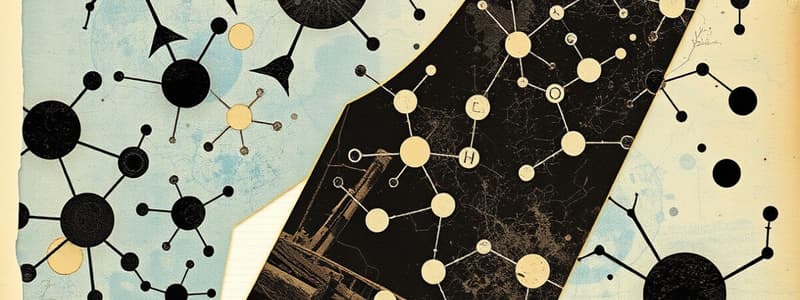Podcast
Questions and Answers
What is the primary role of enzymes in biochemical reactions?
What is the primary role of enzymes in biochemical reactions?
- To lower the activation energy required for reactions (correct)
- To stabilize intermediate compounds
- To increase the activation energy
- To act as substrates for the reactions
Which of the following is NOT a function of carbohydrates?
Which of the following is NOT a function of carbohydrates?
- Energy source
- Stored energy
- Catalyze biochemical reactions (correct)
- Structural components
Which biomolecule is responsible for carrying genetic information?
Which biomolecule is responsible for carrying genetic information?
- Proteins
- Carbohydrates
- Nucleic acids (correct)
- Lipids
In which process does catabolism primarily take place?
In which process does catabolism primarily take place?
What is a characteristic of lipids in biological systems?
What is a characteristic of lipids in biological systems?
How do mutations affect proteins?
How do mutations affect proteins?
Which of the following techniques is used to separate components of mixtures in biochemistry?
Which of the following techniques is used to separate components of mixtures in biochemistry?
What is the role of cAMP in signal transduction?
What is the role of cAMP in signal transduction?
Flashcards are hidden until you start studying
Study Notes
Overview of Biochemistry
- Biochemistry is the study of chemical processes and substances in living organisms.
- It combines principles of biology and chemistry to understand the molecular mechanisms of life.
Key Biomolecules
-
Proteins
- Made up of amino acids; essential for structure, function, and regulation of the body's cells and tissues.
- Enzymes are a type of protein that catalyze biochemical reactions.
-
Nucleic Acids
- DNA (deoxyribonucleic acid): Carries genetic information.
- RNA (ribonucleic acid): Involved in protein synthesis and gene expression.
-
Carbohydrates
- Sugars and starches; serve as energy sources and structural components.
- Monosaccharides (e.g., glucose), disaccharides (e.g., sucrose), polysaccharides (e.g., cellulose, glycogen).
-
Lipids
- Fats, oils, and phospholipids; important for cell membranes and energy storage.
- Triglycerides, steroids, and waxes are common lipid types.
Metabolism
- Catabolism: Breakdown of molecules to release energy (e.g., glycolysis, Krebs cycle).
- Anabolism: Synthesis of larger molecules from smaller units, requiring energy (e.g., protein synthesis).
Enzyme Function
- Enzymes lower the activation energy required for reactions, increasing reaction rates.
- Factors affecting enzyme activity include temperature, pH, and substrate concentration.
Cellular Components
- Cell Membrane: Phospholipid bilayer with embedded proteins; regulates transport and communication.
- Organelles: Structures within cells (e.g., mitochondria for energy production, ribosomes for protein synthesis).
Signaling Pathways
- Chemical signals (hormones, neurotransmitters) trigger specific cellular responses.
- Signal transduction involves receptors and secondary messengers (e.g., cAMP).
Genetic Biochemistry
- Genetic code translates DNA sequences into proteins through transcription (DNA to RNA) and translation (RNA to protein).
- Mutations can alter protein function and lead to diseases.
Techniques in Biochemistry
- Chromatography: Separates components of mixtures.
- Electrophoresis: Separates nucleic acids or proteins based on size and charge.
- Spectroscopy: Analyzes the composition of substances.
Applications of Biochemistry
- Medicine: Drug development, genetic engineering, diagnostics.
- Agriculture: Biotechnology in crop improvement and pest resistance.
- Environmental Science: Bioremediation and studying metabolic pathways in ecosystems.
Overview of Biochemistry
- Biochemistry focuses on chemical processes and substances in living organisms, merging biology and chemistry.
- Understanding molecular mechanisms is crucial for grasping how life functions.
Key Biomolecules
-
Proteins:
- Composed of amino acids; vital for cellular structure, function, and regulation.
- Enzymes, a subset of proteins, catalyze biochemical reactions, enhancing reaction rates.
-
Nucleic Acids:
- DNA (deoxyribonucleic acid): Holds genetic information, critical for heredity.
- RNA (ribonucleic acid): Plays a key role in protein synthesis and gene expression processes.
-
Carbohydrates:
- Consists of sugars and starches that serve as energy sources and structural elements.
- Variants include monosaccharides (e.g., glucose), disaccharides (e.g., sucrose), and polysaccharides (e.g., cellulose, glycogen).
-
Lipids:
- Comprises fats, oils, and phospholipids essential for cell membrane structure and energy storage.
- Includes triglycerides, steroids, and waxes, which serve various biological functions.
Metabolism
- Catabolism: Involves the breakdown of molecules to release energy, exemplified by glycolysis and the Krebs cycle.
- Anabolism: Refers to the synthesis of larger molecules from smaller ones, which requires energy, such as in protein synthesis.
Enzyme Function
- Enzymes catalyze reactions by lowering activation energy, thereby accelerating reaction rates.
- Activity of enzymes is influenced by factors like temperature, pH, and substrate concentration, which can modulate their efficiency.
Cellular Components
- Cell Membrane: A phospholipid bilayer embedded with proteins, crucial for regulating transportation and intercellular communication.
- Organelles: Specialized structures in cells, such as mitochondria (energy production) and ribosomes (protein synthesis).
Signaling Pathways
- Chemical signals, including hormones and neurotransmitters, initiate specific cellular responses.
- Signal transduction relies on receptors and secondary messengers like cAMP to propagate signals within cells.
Genetic Biochemistry
- The genetic code facilitates the translation of DNA sequences into proteins via transcription (DNA to RNA) and translation (RNA to protein).
- Mutations in DNA can modify protein function, potentially leading to various diseases.
Techniques in Biochemistry
- Chromatography: Utilized for separating components within mixtures for analysis.
- Electrophoresis: Separates nucleic acids or proteins according to size and charge.
- Spectroscopy: Examines the composition and structure of substances through interaction with light.
Applications of Biochemistry
- Medicine: Involves drug development, advances in genetic engineering, and diagnostic testing.
- Agriculture: Biotechnology enhances crop traits and resistance to pests.
- Environmental Science: Engages in bioremediation efforts and explores metabolic pathways in ecological systems.
Studying That Suits You
Use AI to generate personalized quizzes and flashcards to suit your learning preferences.




